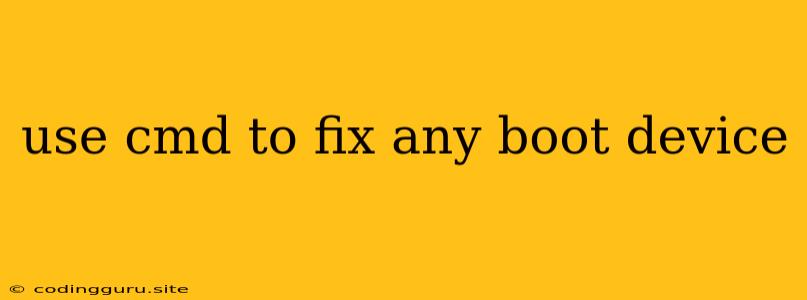Troubleshooting Boot Device Errors Using the Command Prompt
Ever encountered the dreaded "Boot Device Not Found" or "Operating System Not Found" error message upon starting your computer? These errors can be incredibly frustrating, as they prevent you from accessing your operating system. While these issues can stem from various factors, a common culprit is a problem with the boot device (usually your hard drive or SSD).
Fear not, as the trusty Command Prompt can often be your savior in such scenarios. This powerful tool allows you to interact directly with your computer's operating system, enabling you to diagnose and fix boot-related issues.
Understanding Boot Device Errors:
Before delving into solutions, let's briefly understand why these errors occur:
- Damaged Boot Sector: The boot sector is a crucial part of your hard drive containing the instructions needed to load the operating system. Corruption in this sector can prevent your computer from finding the necessary files to boot properly.
- Incorrect Boot Order: The BIOS or UEFI firmware determines the order in which your computer checks for bootable devices. If the boot order is set incorrectly, your computer might be attempting to boot from a device that doesn't contain a valid operating system.
- Hardware Failure: A failing hard drive or SSD can also cause boot device errors. If the device is physically damaged, your computer might not be able to access its data, including the boot sector.
Using the Command Prompt to Diagnose and Fix Boot Device Errors:
Now, let's explore how the Command Prompt can help you troubleshoot and potentially resolve these errors:
Step 1: Accessing the Command Prompt
To access the Command Prompt, you'll need to boot your computer into Safe Mode or use a bootable USB drive or CD. Here's how you can access the Command Prompt from these options:
1. Booting into Safe Mode:
* Restart your computer and press the appropriate key (usually F8 or F11) during the boot process to access the Advanced Boot Options menu.
* Select **Safe Mode with Command Prompt**.
2. Using a Bootable USB Drive or CD:
* Create a bootable USB drive or CD containing a recovery environment (such as a Windows installation disc or a Linux distribution).
* Boot your computer from the USB drive or CD and select the option to open the Command Prompt.
Step 2: Checking the Boot Order
-
Identify the Boot Device: Open the Command Prompt and type the following command:
bcdedit /enumLook for the entry labeled "device". This will reveal the current boot device.
-
Change the Boot Order (if needed): If the boot device is incorrect, you can adjust it using the bcdedit command. However, this requires knowing the correct device identifier. Refer to your computer's documentation or BIOS/UEFI settings for the device IDs.
bcdedit /set {bootmgr} deviceReplace
<device_identifier>with the correct device identifier.
Step 3: Repairing the Boot Sector
-
Check for Errors and Repair: Run the chkdsk command to scan your hard drive for errors and attempt to repair them:
chkdsk /r: Replace
<drive_letter>with the letter representing your hard drive (usually C:). -
Rebuild the Boot Sector: If chkdsk fails to repair the boot sector, you can use the bootrec command to rebuild it:
bootrec /fixbootThis command will overwrite the existing boot sector with a new, healthy one.
-
Reconstruct the BCD Store: If you're experiencing issues with the BCD (Boot Configuration Data) store, you can use the bootrec command to rebuild it:
bootrec /rebuildbcdThis command will scan your computer for existing operating systems and add them to the BCD store.
Step 4: Checking for Hardware Failures
If none of the above steps resolve the boot device error, it's possible that the problem lies with your hard drive or SSD. You can run diagnostic tools provided by the drive manufacturer or use a third-party tool to assess the health of your storage device.
Additional Tips for Troubleshooting Boot Device Errors:
- Update your BIOS/UEFI firmware: Outdated firmware can sometimes cause boot issues. Check your computer manufacturer's website for the latest updates.
- Disconnect any unnecessary peripherals: External devices like USB drives or optical drives can sometimes interfere with the boot process. Disconnect them and try booting again.
- Consider reinstalling your operating system: If all else fails, reinstalling your operating system might be necessary to resolve the issue.
Conclusion
While encountering a "Boot Device Not Found" error can be alarming, using the Command Prompt and following these steps can often help you diagnose and fix the problem. Remember to be careful when modifying boot-related settings, and consult online resources or professional help if you're unsure about any specific commands or steps. By understanding the basics of boot device errors and mastering the Command Prompt, you'll be better equipped to tackle these issues effectively.
